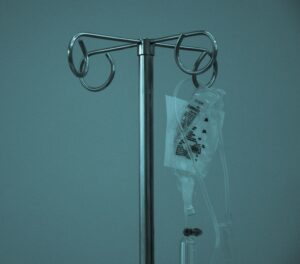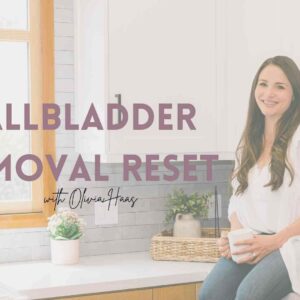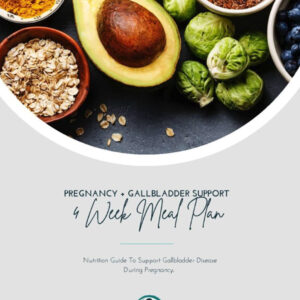What You Need to Know About Gallbladder Removal and Recovery
Did you know that in the United States over 600,000 people undergo gallbladder removal surgery each year?
Gallbladder removal surgery, or cholecystectomy, is a common procedure, often performed to resolve issues like gallstones or gallbladder inflammation.
If you’re facing this surgery, it’s normal to feel a mix of relief and nervousness.
So as a integrative gallbladder nutritionist AND someone who has helped hundreds of people prepare for their surgery,
I wanted to educate you on some of the most important steps when you’re preparing for your gallbladder removal surgery to make sure you have a smoother and less overwhelming journey.
What signs and symptoms may indicate gallbladder removal?
Gallbladder removal is available for a reason. There are cases where a natural approach is not recommended and contraindicated. This can vary depending on many factors and it is important you discuss with a surgeon.
These maybe some reasons why removal is recommended and the best option:
- Chronic biliary attacks- especially after diet and lifestyle change.
- Frequent gallbladder inflammation and infection.
- Pigment bile stones
- Porcelain gallbladder wall
- Thickened or calcified gallbladder wall. Both cases inhibit gallbladder function and are more advanced gallbladder cases
- Large gallbladder polyps or numerous polyps that grow in a short period of time.
Questions to ask your surgeon?
Now you maybe feeling concerned about removal of the gallbladder, being prepared and asking the right questions will help you feel less ease with your decision. These are some questions to ask? 
- What is the recovery timeline?
- When can I return back to work and exercise?
- What diet should I follow after removal? if your surgeon does not provide proper dietary recommendations please reference my Post Gallbladder Surgery nutrition book
- Does my gallbladder diagnosis warrant removal?
- Am I a candidate for ursodiol?
- What are the short term and long term side effects?
How to get ready for a cholecystectomy?
Knowing that you will have an upcoming surgery can be extremely overwhelming, especially if you don’t have enough information about the process.
There are a couple of steps you have to follow to make sure that the procedure goes as smoothly as possible.
1-Initial consultations and medical evaluations
To start the process, you generally meet with a surgeon who specializes in gallbladder removal.
During this initial consultation, the surgeon will evaluate your condition and discuss the surgical options available.
In addition to the consultation, blood tests and imaging scans, such as an ultrasound or a computed tomography (CT) scan, may be ordered to assess your gallbladder’s condition and rule out any other potential problems.
Also, your surgeon will mostly want to have a quick discussion with you if there are any risks and complications with your gallbladder removal surgery.
2- Dietary changes and fasting requirements
Leading up to the surgery, you will need to make specific dietary changes and follow some of the fasting requirements.
This is usually one of the most important steps in your surgery preparation.
You’ll need to avoid certain foods, especially ones that are high in fat and cholesterol as these nutrients can easily elevate your gallbladder symptoms.
Instead, adopting a diet that is rich in fruits, vegetables, and whole grains would be a much better way to prepare for your surgery.
In terms of fasting, you will need to abstain from eating or drinking for a certain period before the surgery.
Proper fasting management, including following the precise instructions provided by the surgeon or medical team, is essential to ensure an empty stomach and reduce the risk of aspiration during anesthesia.
It is equally important for patients to stay well-hydrated in the days leading up to the surgery and to maintain a balanced diet to optimize their overall health and support their body’s ability to heal.
3- Lifestyle adjustments before surgery
In addition to dietary modifications and fasting requirements, certain lifestyle adjustments may be necessary before undergoing gallbladder removal surgery.
You may be asked by your healthcare provider to stop taking certain medications or supplements that could potentially interfere with the surgery or postoperative recovery.
It’s extremely vital to give your physician a comprehensive understanding of your medication history.
Another crucial factor is the cessation of smoking and alcohol consumption weeks before the surgery as smoking can impair the healing process and alcohol can interact with anesthesia and pain medications.
Finally, mental and emotional preparation is equally important.
This part is usually one of the topics we put the majority of our focus on with my gallbladder clients.
It is extremely natural to experience anxiety or fear before undergoing surgery,
So it is important to take part in self-care activities, seek support from loved ones, avoid social groups or google, and communicate openly with the surgical team to alleviate any concerns or worries.
What Are the Different Surgical Approaches?
There are 2 main ways to remove a gallbladder: laparoscopic surgery and open surgery.
Let’s dive into what these are and how they are performed.
Laparoscopic gallbladder removal
Laparoscopic gallbladder removal, also known as minimally invasive surgery, is the most common approach for gallbladder removal.
It involves making small incisions in the abdomen and using specialized surgical instruments and a camera to remove the gallbladder.
 Here’s a simple breakdown of how it’s done:
Here’s a simple breakdown of how it’s done:
First, the doctor fills your belly with carbon dioxide gas to create a better view of the internal organs.
Then, they make small cuts and use special tools and a tiny camera to get to your gallbladder.
This camera is super helpful because it lets the surgeon see everything on a screen and carefully remove the gallbladder.
After the gallbladder is out, the cuts are closed up, usually with stitches or a special glue.
This method is really popular because you don’t have to stay in the hospital for long, there’s less pain, and you get better faster.
However, based on your health or the condition of your gallbladder, a different kind of surgery might be needed.
Open gallbladder removal surgery
Although laparoscopic surgery is our go-to choice, it’s not suitable for everybody.
In certain cases where laparoscopic surgery is not safe, open gallbladder removal surgery may be necessary.
This traditional surgical approach involves making a larger incision in the abdomen to directly access and remove the gallbladder.
Indications for open surgery include severe inflammation, scarring, or complications arising from previous surgeries in the abdominal area.
The surgeon will carefully evaluate the patient’s individual circumstances to determine the most appropriate approach.
Recovery from open surgery typically requires a longer hospital stay compared to laparoscopic surgery, and the postoperative pain may be more significant.
However, the surgeon will closely monitor the patient’s progress and provide appropriate pain management techniques to alleviate discomfort.
Anesthesia and postoperative monitoring
During gallbladder removal surgery, various types of anesthesia can be used to ensure the patient’s comfort and safety.
The specific choice of anesthesia will depend on the patient’s overall health, preferences, and the surgeon’s recommendations.
General anesthesia, which involves being completely unconscious throughout the surgery, is commonly administered.
This makes sure that the patient does not experience any pain or discomfort during the procedure.
After the surgery, the patient will be taken to the recovery room, where their vital signs and overall condition will be closely monitored.
It is important to ensure stable blood pressure, heart rate, and respiration.
Pain management will also be initiated to keep the patient as comfortable as possible during the initial stages of recovery.
Recovery and Postoperative Care
After your gallbladder removal surgery, here’s what typically happens:
Post-surgery, you’ll first rest in a recovery area as you gently wake up from the anesthesia.
When you’re ready, you’ll be moved to a regular hospital room to continue your recovery. The length of your recovery really depends on the type of surgery you had.
moved to a regular hospital room to continue your recovery. The length of your recovery really depends on the type of surgery you had.
Laparoscopic Cholecystectomy: This is the less invasive procedure with those small incisions. Many people get to go home on the same day of their surgery.
However, sometimes your doctor may recommend you to stay in the hospital for one night after evaluating your ability to eat and drink without pain,
And whether you can walk around without any help. Generally, you’re looking at about a week for a full recovery.
Open Cholecystectomy: If you had the open surgery, which is a bit more involved, expect to stay in the hospital for a couple of days, usually 2 to 3 days, for recovery.
Once you’re back home, it could take about 4 to 6 weeks to fully recover.
Remember, everyone’s body is different, and these timelines can vary. The most important thing is to listen to your body and follow your healthcare provider’s instructions for a smooth recovery.
Pain management and medication
After your gallbladder surgery, managing pain is one of the key things on most people’s minds.
Pain levels and how you handle them can vary. There are different methods that doctors use to keep you comfortable.
They usually prescribe pain relief medications, like opioids or NSAIDs. Although these are effective, it’s good to know their side effects like feeling sleepy, constipation, or in rare cases, allergic reactions.
Besides medication, there are also non-drug ways to help with the pain.
You might find relief with heat or cold packs applied to the surgery area, doing some relaxation exercises, or even distraction techniques.
Dietary Recommendations and Lifestyle Modifications
Post-surgery, continuing to practice a healthy diet and lifestyle is extremely important to reduce the risk of common side effects and symptoms following surgery.
Even without a gallbladder, your body will adapt, but certain changes in your diet can make this transition smoother.
A typical diet for about 14 days after gallbladder removal starts with small, low-fat meals. Gradually, you can increase the portion size and introduce more fats.
It’s also a good idea to have smaller meals more frequently, rather than a few large ones. This can help to manage digestion in a better way.
Continue to practice a health promoting diet with whole foods, protein, vegetables, fruits and whole grains. This reduces the risk of many digestive and metabolic side effects of cholecystectomy.
Ready for More Post-Operative Support?
So hopefully, I was able to gives you more insight for preparing for surgery.
I understand that undergoing surgery and adapting to life afterward can be challenging.
It’s not just a physical journey, but an emotional one too. That’s why having support and guidance from someone who truly understands what you’re going through can be invaluable.
This is why I’ve created the Gallbladder Removal Reset program, which is my step-by-step course to restore your health and digestion post-gallbladder removal.
As a functional gallbladder nutritionist and someone who has been in your shoes, I know the ups and downs that come with this experience.
So, if you’re looking for that extra support, guidance, and a community that gets it, I invite you to join us in the Gallbladder Removal Reset program.
There’s so much I can offer you, and I can’t wait for you to take charge of your gallbladder disease and start feeling your best!

